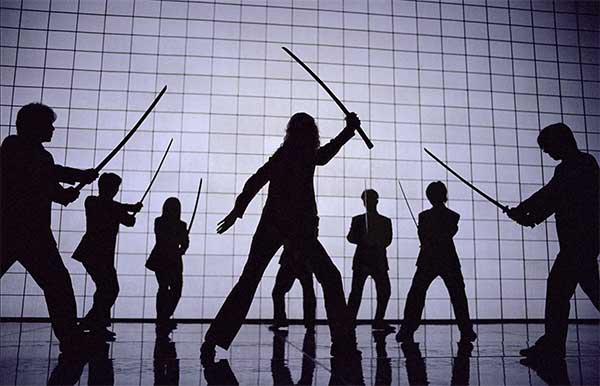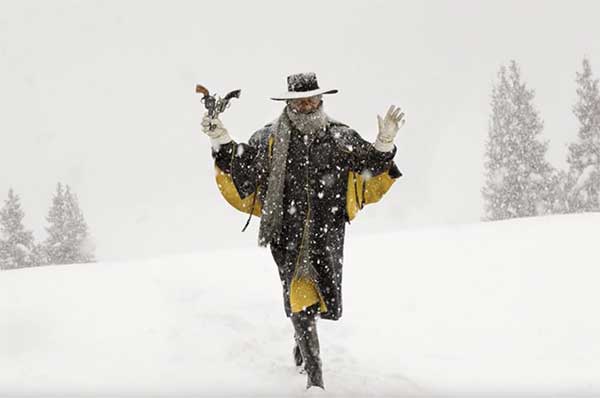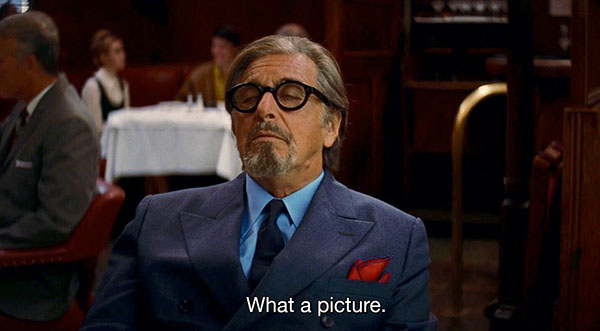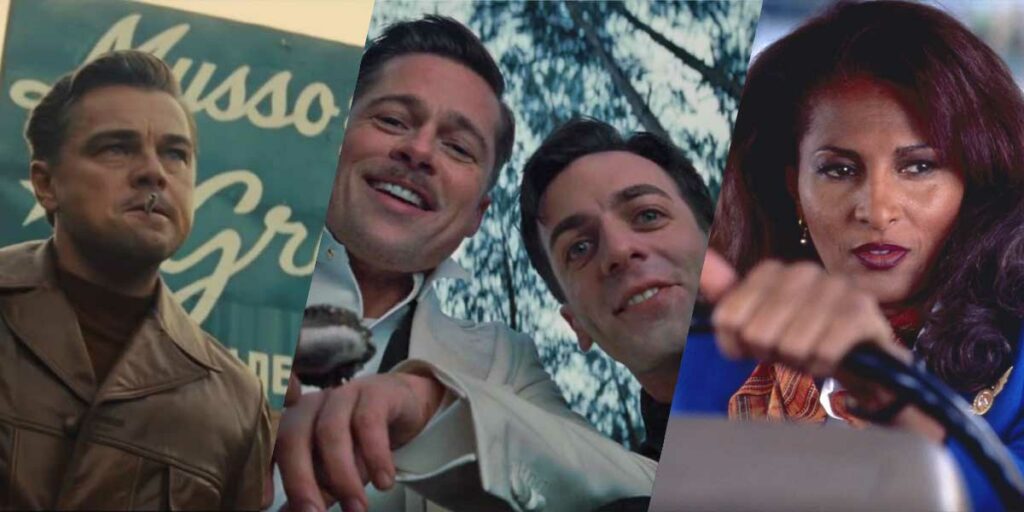We’ve ranked the nine films of Quentin Tarantino from worst to best in celebration of one of our favorite directors and most divisive movie-makers in Hollywood.
It’s the desire of any artist that their talent, their subjects, and their artistic outputs evolve over the trajectory of their career. Quentin Tarantino is one of the best mainstream, high-profile examples of this notion, with each subsequent entry in his mind-numbingly diverse cinematic portfolio improving upon its predecessor. That being said, the nine feature films under his belt are not as easily ranked from nine to one by beginning with the first and ending with the most recent. So, I’ve gone through and rewatched the entire filmography of one of our most divisive master crafters of the cinematic art form and ranked each entry from worst to best.
9. Kill Bill: Volume 2 (2004)

“You’re not a bad person. You’re a terrific person. You’re my favorite person but, every once in a while, you can be a real c*nt.”
It’s not easy deeming any one entry in Tarantino’s filmography as his “worst” but the ranking has to start somewhere. For my money, Kill Bill: Volume 2 is the least memorable effort of his, though not without its merits. But when my brain thinks “Tarantino”, the technicolor orgy in my mind’s eye is filled with so many other moments, characters, one-liners, needle-drops, exploding heads, and f-bombs before even a whiff of Volume 2 sneaks in.
This isn’t to suggest that it isn’t a bad motherfucker of a Tarantino flick (because it is). That said, the success of Volume 2 lies in its symbiosis with Volume 1 where, together, they make up one vengeful bitch of a dish best served with an adrenaline samurai-sword-EpiPen straight to the sternum.
8. Pulp Fiction (1994)
“Could you, um, roll me one of those, cowboy?”
In the nearly thirty years since its release, the Pulp Fiction praise chorus has been sung by every film bro under the sun to the tune of its being one of the undisputed champions of cinema, and for good reason: its bombastic emergence onto the Hollywoods scene in the 90s as a subversive juggernaut of pulpy proportions easily cemented its cooler than cool status as one of The! Fucking! Films! of the time.
The question I have is, what does the film do for me today?
It’s not lost on me how major of a cultural touchstone Pulp Fiction is, both for movie-lovers at large and Tarantino himself. QT cannonballed into the pop culture deep end with Reservoir Dogs in ‘92 and went on to prove he wasn’t a one-hit wonder with Pulp Fiction a couple of years later. The point is that he didn’t peak with Pulp– it’s actually the opposite: the groundwork laid by Pulp Fiction allowed Tarantino to drive his career through Hollywood down a road most filmmakers only dream of setting foot on, let alone careening down at 150 miles an hour in a flaming monster truck. That road being “I can do whateverthefuck I want” boulevard.
Look, I’m not out here standing on a soapbox, screaming into the void “I’m right and you’re wrong” about one of the most lauded films of all time. To each their own, especially when it comes to the things from which we derive entertainment. My point is, is the legacy of the film bigger and better than the film itself?
On the rewatch, as a 30-year-old in 2023, Pulp Fiction is my least favorite Tarantino flick. The tone of the film–its fabric, its function, its freneticism– that was heralded as a revolution in the mid-90s doesn’t hold up for me. It’s a movie that doesn’t serve as much more than a middle-of-the-road, moderately entertaining if slightly bloated, grungy romp with a handful of good performances, a handful of good tunes, and a handful of scenes so memorable and deeply ingrained into the DNA of pop culture that you don’t even have to have seen the film to get the reference.
7. Django Unchained (2012)
“It’s like a reward.”
Are any of Tarantino’s films not bad motherfuckers? Django Unchained checks that box and then some. It’s maybe the closest one of his films has come to an “epic”, infused with his signature brand of badassery while serving as a pivotal entry in the 21st century revisionist Western resurgence.
Tarantino and mainstay DP Robert Richardson work at the height of their filmic powers here; never has a QT flick felt as big as Django. Slap another banger anachronistic soundtrack on there, plus a roster of some of the best actors working today, and boy, howdy, you’ve got yourself a hit. And they did: Django Unchained remains the box office champ of Tarantino’s filmography with a worldwide total of $450 million.
Django finds Tarantino continuing his newfound station of being a “master at work,” at a time when he could have just as easily reverted back to the grindhouse days of yore following his critically adored and accolade-laden Inglourious Basterds. And he doesn’t just sacrifice what makes his movies great for another chance at vapid Oscar glory; Django Unchained sports just as much blood and guts and bad-ass-motherfuckery as its predecessors. And it was still nominated for a handful of Oscars. And won two. Not bad.
6. Kill Bill: Volume 1 (2003)
“B*tch, you don’t have a future.”
The success of Reservoir Dogs, Pulp Fiction, and even Jackie Brown (underappreciated as it was at the time of its release) continued to bolster Tarantino’s upward trajectory into the “doing whatever the hell he wants” stratosphere. 2003’s Kill Bill: Volume 1 is a bravura firework spectacular of martial arts and blood spatters, delivered by no overly-gratuitous means thanks to the beating-heart revenge tale at its core.
Volume 1 might top Tarantino’s filmography as the biggest ass-kicker of the bunch. It’s his first big swing at a full-blown genre cocktail, blending elements of martial arts films, Chanbara, blaxploitation, anime, and spaghetti westerns to the tune of his trademark blink-and-you-miss-it pacing, with a killer Sally Menke edit to weave it all together.
As good as Volume 1 is on its own, and if you’ve got 215 minutes to spare, there’s no reason you shouldn’t engage with the pair in the form of Kill Bill: The Whole Bloody Affair, exactly the way the man himself intended it.
5. The Hateful Eight (2015)

“Well, you better sh*t another pistol out your ass, ‘cause if you don’t throw one up here in the next two seconds, we’re gonna kill this b*tch.”
I’m a sucker for a Bottle episode. I love a self-contained story that exists in (more or less) the same place, in (more or less) real-time, with (more or less) the same handful of characters from beginning to end. Then throw Samuel L. Jackson, Jennifer Jason Leigh, Tim Roth, Walton Goggins, Kurt Russell, Bruce Dern, Michael Madsen, and Demián Bichir in there and stick ‘em in a blizzard-flanked cabin in the middle of 1877 Wyoming? Hot dog, you’ve got yourself a picture.
Now, you can have your cozy settings and your fancy pistols and your Sam Jacksons and the like, but the caveat here is that, when it comes to a self-contained, bottle episode in the form of a 188-minute revisionist Western, there’s a fine line between a concept like that working and the unshakable “why didn’t they just make this a play?” feeling.
Tarantino accomplishes the former in The Hateful Eight and, with it, delivers such a spectacularly engrossing cinematic achievement, it’s strange to think why this is one of his most minor works. There are plenty of bullets exploding blood and guts out the back of people’s heads to go around as any of his previous flicks. Maybe it’s not so strange, though, following a box office juggernaut and critically acclaimed epic like Django, but I’m still beating the Hateful Eight drum eight years on whether anyone’s with me or not.
4. Reservoir Dogs (1992)
“You shoot me in a dream, you better wake up and apologize.”
I mean, this is the reason for the season. Former video store clerk Quentin Tarantino’s feature debut in January of ‘92 at the Sundance Film Festival all but sealed his fate as a household name–at least among industry folks, to start–whether he proved to be a one-hit wonder or not.
Reservoir Dogs, not unlike The Hateful Eight, feels like it could just as easily be conceived as a play; of all the signatures Tarantino brings to the table, chiefly among them is his uncanny ability to write dialogue. And whether that dialogue is driving the story (here, Hateful Eight, Jackie Brown) or the action is in the driver’s seat (Kill Bill, Django), the words coming out of the mouths of the talent Tarantino never fails to bring on board remain the artistic centerpiece of the entire operation.
Reservoir Dogs is a messy, sweaty, jittery, anxiety-inducing, balls-to-the-walls heist flick about a bunch of dudes yelling at and eventually shooting each other. It’s Tarantino at his loudest, and for a good reason: you don’t churn out a debut like this, fully certain you’re going to have any semblance of a career afterward. Much to the delight of audiences for the three-and-counting decades to follow Reservoir Dogs, that was never worth losing any sleep over.
3. Jackie Brown (1997)
“My ass may be dumb but I ain’t no dumbass.”
Quentin Tarantino has written each of his films based on original concepts that materialized inside what must be a pandemonium party of a brain, with the exception of one. He adapted Rum Punch by the late, great Elmore Leonard into what would become his most underrated and most deeply character-driven film to date: Jackie Brown.
Some say Jackie Brown is QT’s best, others say it’s the least Tarantino-y of all. There’s validity to both claims, and it’s certainly true that it’s the most even-keeled film in his canon. The transition from page to screen, and the adoration for the source with which Tarantino carefully crafts it, results in his most linear and least idiosyncratic effort to date, though never at the expense of dynamite dialogue, depth of character, and Sam Jackson saying any and all variants of “f*ck” as much as possible.
Jackie Brown could be Tarantino’s most adult film, so to speak; where his other works feel like the product of a kid hopped up on caffeine and red dye no. 4, let loose around a playground with millions of dollars to do with as his heart desires, Jackie Brown is QT at his most measured, without once sacrificing the bad-motherfuckery that made him who he is today.
2. Inglourious Basterds (2009)
Where to Watch: Get the limited edition 4K ultra HD boxset!

“That’s a bingo.”
Tarantino’s career can be marked by two distinct epochs. The first begins with Reservoir Dogs and ends with Kill Bill: Volume 2. That first section of his career is marked by a distinct grittiness, a penchant for these intense, brutal stories about real people whose lives and/or livelihoods are on the line for one reason or another. It’s all about guns, and cash, and cigarettes, and briefcases, and fighting, and revenge, and betrayal, and cars peeling around street corners, and the heat of the Southern Californian sun, and the Hawaiian shirts worn to beat it. This first wave of Tarantino is defined by its real-world anxiety, claustrophobia, messiness, and sweat.
Inglorious Basterds heralded the second epoch of Tarantino’s career. Not only did Basterds mark the beginning of his infatuation with period settings (he hasn’t set a film in the present since Kill Bill), but tonally, and even thematically, it steers ever so slightly–so as not to give us whiplash–away from the pulp and grindhouse aesthetics of yesteryear.
When this hit theaters, my exposure to Tarantino was limited. I rented Pulp Fiction and watched it because I thought I was supposed to. I’d seen a handful of bits from Reservoir Dogs. I watched an edited-for-television version of Kill Bill: Volume 1 which couldn’t have been more than 10 minutes long. I fondly remember seeing Inglorious Basterds at a tiny two- or three-screen theater in Vermont, and coming out the other end a changed 16-year-old (I wasn’t; I was just an overzealous 16-year-old).
Close your eyes and point. You won’t find a single scene or performance across its 153-minute runtime that isn’t worth rewatching multiple times. For me, Basterds is one of those “if I catch it on cable partway through I’ll sit there and watch till the end” films. Full disclosure: I don’t watch cable television anymore but, like… you get it. It’s also worth noting that this gave us Christoph Waltz, at least in the capacity that American audiences have him now and likely wouldn’t have if not for this film.
Ultimately, Tarantino made a film in which the power of cinema defeats Hitler and the Nazis. It’s a big swing in terms of revisionist history, even for someone as insane as Tarantino, that simply would not work if he weren’t so damn good.
1. Once Upon a Time…in Hollywood (2019)
“I try.”
Ask Tarantino himself what he considers to be his best film and, after rattling off a lot of stream-of-consciousness nonsense that’s just as entertaining whether or not you understand it, he’ll probably arrive at an answer for you, and it’s Once Upon a Time in Hollywood. At least, that’s what he told Howard Stern.
Real talk: I didn’t like this when I saw it in theaters. After hearing the massive hubbub surrounding it (And why wouldn’t there be? “The new Tarantino” are the only three words you need.), I was jazzed to finally see it but found myself walking out of the theater majorly disappointed, wondering if I had somehow seen a different cut than everyone else. It landed as a pretty middling effort, if not one of Tarantino’s worst. Still, there was a sliver of my heart open to the prospect of my mind being changed on the rewatch, if I ever even got around to giving it the time of day again. Thankfully, I did, and I rewatched it a second, third, and fourth time. To this day, I don’t know what had crawled up my butt and died during that first viewing but, honestly, it’s not even worth trying to figure out
Once Upon a Time in Hollywood is the most fully realized version of Tarantino as an artist, operating on such a masterclass level that every scene, cut, pan, zoom, look, montage, needle drop, and lens flare is the clear result of an artist with full-control over his subject. If, for whatever reason, you wouldn’t have referred to him as an auteur before Once Upon a Time in Hollywood, there’s no way you couldn’t after it. Maybe the only reason you wouldn’t already have been referring to him as an auteur is because you didn’t know what the word “auteur” meant. And, if you still don’t, you’re reading this on the internet. Open a new tab and look it up. Learning is fun, I promise.
This film is fucking tight. For a story that sprawls as all over the place as it does–jumping between the split narratives of Rick and Cliff, the Sharon Tate business, the folding in and out of flashbacks, the in-universe television and movie sequences made just for the film–Tarantino never once takes his eye off the ball. It feels like an “all roads led here” deal, in that each film that came before it has served as a piece of the larger Tarantino cinematic puzzle that, when put together, looks a lot like Leo and Brad riding around Hollywood in a ‘66 Cadillac Coupe DeVille. If One Upon a Time in Hollywood is the artistic culmination of everything Tarantino’s honed over the course of his career, I can’t wait to see what he delivers with his 10th (and hopefully not final) film.


